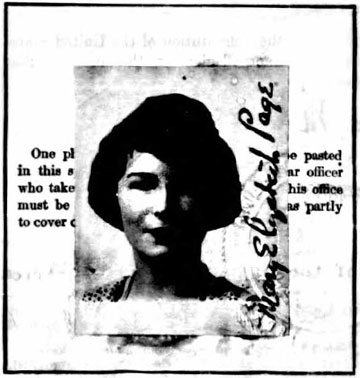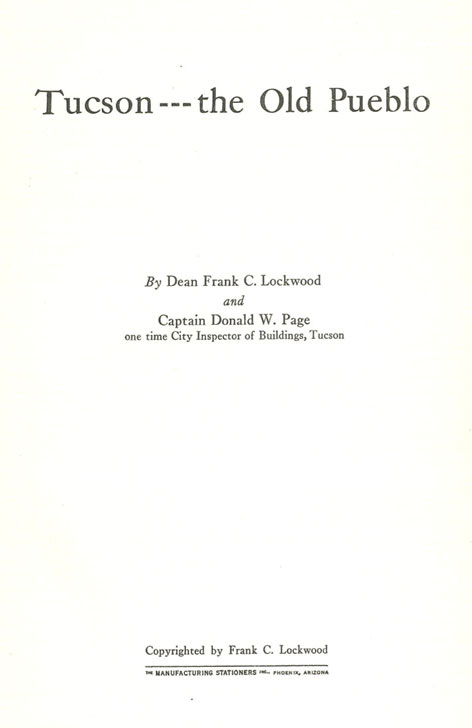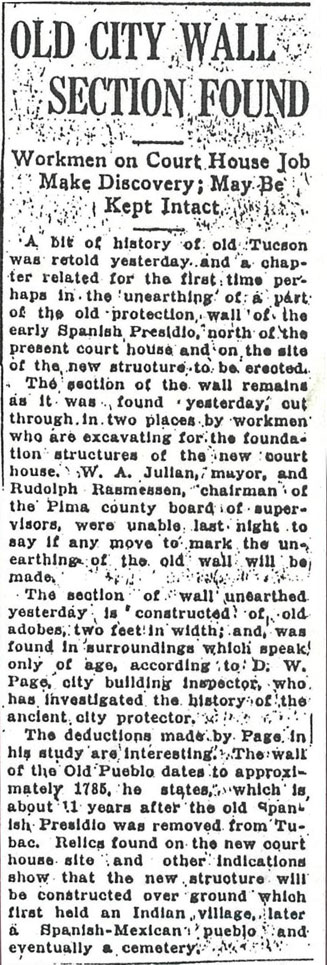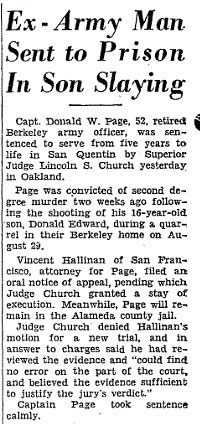
Donald Page: Tucson’s Tragic First Historical Archaeologist
Historical archaeologist Homer Thiel writes this week’s blog.
Donald William Page only lived in Tucson for three years. But during that time he turned his attention to the community’s history and archaeology. He interviewed elderly residents, explored and mapped ruins, and, in 1929, conducted the first historical archaeological excavation in downtown Tucson at the site of the Presidio San Agustín del Tucson, the Spanish fort constructed in 1776 and in use until 1856.
Page was born in 1884 in Montclair, New Jersey, son of John Page, who worked for the maritime division of the Southern Pacific Railroad, and Julia Robb. The family lived in Mexico in the 1890s and Donald became fluent in Spanish. After graduating from high school, Page took up civil engineering as a profession and was soon working in Mexico and later South America. Page served as a captain in the United States Army Corps of Engineers during World War I, stationed in France.
In January 1920, Page lived in Washington, DC, again working as a civil engineer. While there he married Mary Elizabeth Ober and the couple became the parents of Donald Edmund Page, born in 1922. During the next few years Page lived in Madrid, Spain, working for the Aluminum Company of America, traveling throughout Europe and North Africa.
The Page family moved to Tucson in September 1926 due to Mary’s ill health. She was suffering from tuberculosis and, like many other people, hoped the dry climate would cure her condition. Donald worked as the City’s deputy building inspector for a year, before being fired, perhaps due to his cantankerous personality. In his time off he explored archaeological sites and ruins and talked with old-timers. He teamed up with University of Arizona Dean Frank Lockwood to interview Atanacia Santa Cruz about her childhood in the Tucson Presidio. Atanacia was born in 1850 inside the fortress. She was one of a handful of people who grew up in the Presidio whose memories were recorded by historians. The two men went on to write Tucson- the Old Pueblo.
In January 1929, workmen digging the foundations for the new Pima County Courthouse uncovered human bones from the Presidio Cemetery. Page had been shown the likely location of the adobe walls of the Tucson Presidio and realized they were within the new courthouse footprint. Workers soon unearthed sections of the east Presidio wall, and Page drew a careful map of the walls and brought attention of the find to the press.
He dug exploratory trenches, tracing out the wall, and salvaged adobe bricks. The Tucson Landmarks Committee salvaged other bricks and some were later installed inside a glass case, while others were used to rebuild a section of the Presidio wall on the south side of the new Courthouse (this wall stood until 1955). Today a handful of the bricks are incorporated into a display in the former Pima County Assessor’s office lobby.
Mary Page died on August 4, 1929 from pulmonary tuberculosis. Shortly thereafter, Donald left Tucson. His son was taken to Berkeley, California, to live with his grandmother, Julia Page. By May 1930, Page was stationed in Calcutta, India, working as a Foreign Service Officer for the US government. He eventually returned to the United States and moved in with his mother in Berkeley.
Page’s life turned to tragedy on August 29, 1937. He had been drinking heavily and trying to sleep, but neighborhood boys were being loud. He convinced a 14-year-old friend of his son to lure the boys away and in return, lent him a replica military medal . Page’s son Donald then argued with his father about the medal, and an angry Page shot his son in the stomach with a revolver. The dying teenager told the police his father had done it on purpose.
At the trial held in December 1937, Page’s mother refused to testify against him, claiming he had mental problems. He was convicted of second degree murder and sentenced to San Quentin Prison, where he kept himself busy by preparing a history of the prison and was placed in charge of engineering work there.
Page was released from prison in September 1945. The last few years of his life saw him corresponding with historians in Arizona, sharing information he collected at the Huntington Library in Berkeley and during his time in Tucson. He died on July 24, 1958 and was buried in Arlington Cemetery in Washington, D.C.
Back in 1992, the Center for Desert Archaeology led an excavation to locate the eastern wall of the Tucson Presidio. Our first two-week dig failed to locate the wall, finding instead deep deposits of Territorial, Spanish, and prehistoric materials beneath the grassy lawn. A second dig was planned, but excavations were halted by rain one day. I went to the Arizona Historical Society and looked at Page’s materials. A note on one microfilmed document stated he had drawn a map showing the location of the wall, but I could not find the map. However, I decided to look in the files of Page’s friends and soon found a copy of the map in Gus Schneider’s file. Within the next few days we used the measurements on the map and located the east wall of the Spanish fort.
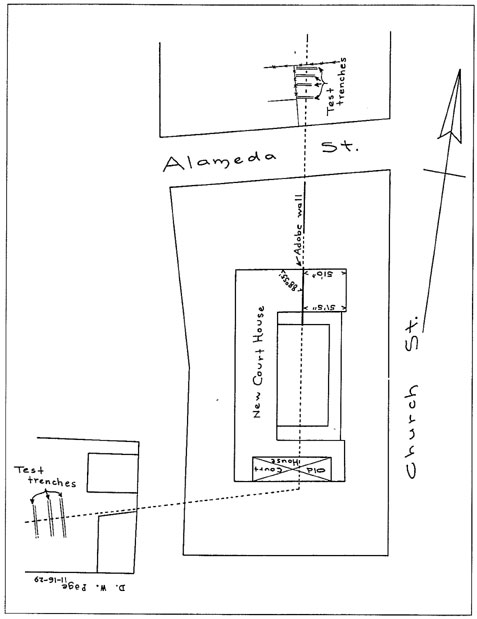
A map drawn by Donald Page showing the location of the Presidio wall and test trenches he excavated in 1929 (Arizona Historical Society, Tucson, MS 715).
Donald Page led a life filled with travel, adventure, and a great love of history. Unfortunately, his problems relating to other humans, something that plagued him throughout his adult life, led to his downfall. In Tucson, he is remembered as the first historical archaeologist and one of the first individuals interested in the community’s Spanish history.



